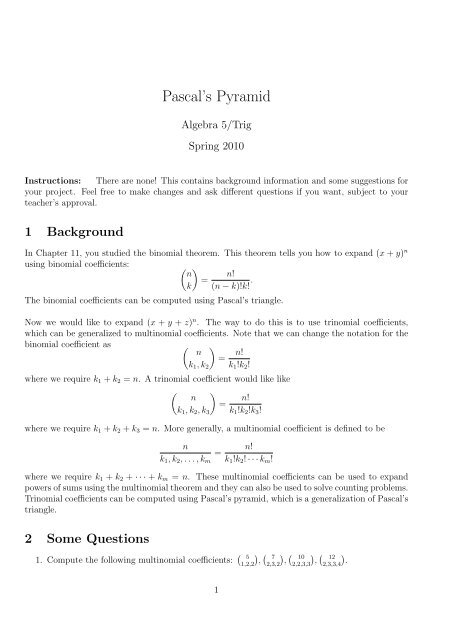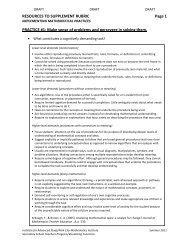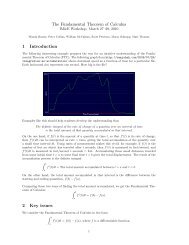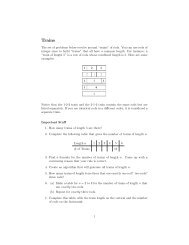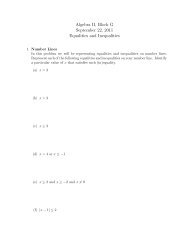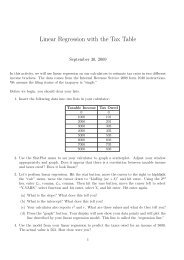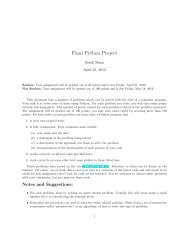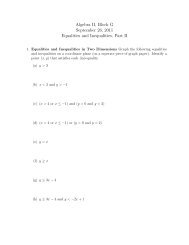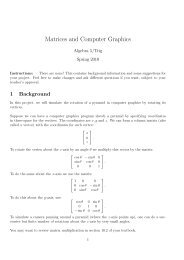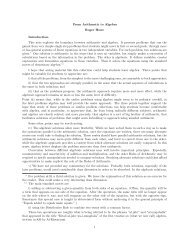Pascal's Pyramid
Pascal's Pyramid
Pascal's Pyramid
You also want an ePaper? Increase the reach of your titles
YUMPU automatically turns print PDFs into web optimized ePapers that Google loves.
Pascal’s <strong>Pyramid</strong><br />
Algebra 5/Trig<br />
Spring 2010<br />
Instructions: There are none! This contains background information and some suggestions for<br />
your project. Feel free to make changes and ask different questions if you want, subject to your<br />
teacher’s approval.<br />
1 Background<br />
In Chapter 11, you studied the binomial theorem. This theorem tells you how to expand (x + y) n<br />
using binomial coefficients: <br />
n<br />
=<br />
k<br />
n!<br />
(n − k)!k! .<br />
The binomial coefficients can be computed using Pascal’s triangle.<br />
Now we would like to expand (x + y + z) n . The way to do this is to use trinomial coefficients,<br />
which can be generalized to multinomial coefficients. Note that we can change the notation for the<br />
binomial coefficient as <br />
n<br />
=<br />
k1, k2<br />
n!<br />
k1!k2!<br />
where we require k1 + k2 = n. A trinomial coefficient would like like<br />
<br />
n n!<br />
=<br />
k1, k2, k3 k1!k2!k3!<br />
where we require k1 + k2 + k3 = n. More generally, a multinomial coefficient is defined to be<br />
n<br />
k1, k2, . . . , km<br />
=<br />
n!<br />
k1!k2! · · · km!<br />
where we require k1 + k2 + · · · + km = n. These multinomial coefficients can be used to expand<br />
powers of sums using the multinomial theorem and they can also be used to solve counting problems.<br />
Trinomial coefficients can be computed using Pascal’s pyramid, which is a generalization of Pascal’s<br />
triangle.<br />
2 Some Questions<br />
1. Compute the following multinomial coefficients: 5<br />
1,2,2<br />
1<br />
, 7<br />
2,3,2<br />
, 10<br />
2,2,3,3<br />
, 12<br />
2,3,3,4<br />
.
2. Read the copied text on multinomial coefficients. Pay attention to:<br />
(a) The formula for the multinomial coefficients,<br />
(b) Pascal’s pyramd,<br />
(c) The multinomial theorem, and<br />
(d) Applications to counting (at the end).<br />
Try to understand how to construct Pascal’s pyramid and the statement of the multinomial<br />
theorem. Ignore the formula labeled “symmetry” and the one labeled “addition.” Also, ignore<br />
the proof of the multinomial thoerem.<br />
3. Construct a model of Pascal’s pyramid.<br />
4. Use the multinomial theorem to expand (x + y + z) 2 and (x + y + z) 3 .<br />
5. Do problems 9, 10 and 11 in the exercises in the copied text. Ignore the other exercises, they<br />
are more theoretical.<br />
Note that the copied text comes from Combinatorics and Graph Theory, second edition, by John M.<br />
Harris, Jeffry L. Hirst, and Michael J. Mossinghoff; published by Springer in their Undergraduate<br />
Texts in Mathematics Series in 2008.<br />
2


